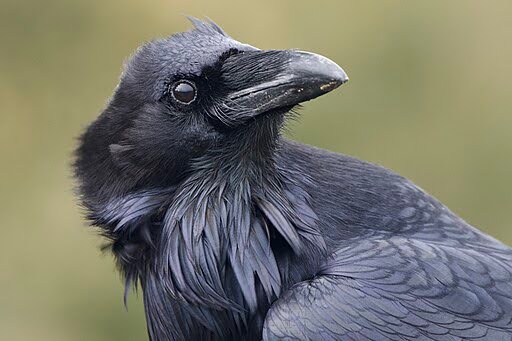By Cathy Warwick.
Most people know that a flock of crows is called a “Murder of Crows” – it’s probably the most popular collective noun for birds. Did you know a flock of Ravens is called an “Unkindness of Ravens”? Still not very cheery, but better than murder. Perhaps some songbirds got together and made these up, they are very apt for their experience of Crows and Ravens. These big black birds love eating eggs from nests.

If you have ever seen a Raven up close you may agree with me when I say they are the more impressive of the two birds. If you want to get a close look at one, take out a sandwich in a ski hill parking lot, the Ravens will come flying in! I always remark on how big they are up close, every time. Their black feathers are so impeccably black they almost bend the light around them. Then they have impressive fluffy neck feathers and a massive black beak. Their intelligent eyes pierce into yours and for a second you may consider throwing the sandwich at them while you make your getaway. I once saw a Raven take a grocery bag of food right out of the back of a truck. As it was flying away I saw there was a box of cereal in its bag, unsurprisingly it had chosen wisely. Ravens are well known for being one of the more intelligent birds.

A Crow is an interesting bird also, smaller than a Raven but also intelligent. They have smaller beaks and smoother feathers. They also tend to flock together more than Ravens. If you have been to Burnaby, BC, which is a known evening roost for Crows, you will see huge flocks, all cawing relentlessly. They are so loud you need to raise your own voice to be heard. I’m not sure what the point of all the cawing is, the first caw sounds exactly like the 1000th, it’s some kind of Crow conversation. Crows have very sophisticated social relationships, which is a big reason for their success as a species.

Photo by Diane Stinson
A big black bird is flying in the air above your neighbourhood, which is it ? A Crow or a Raven? Here is a handy guide to help out:
- Wing movement: a Raven glides and a Crow flaps
- Tail shape: a Raven has a large wedge shaped tail, a Crow has a flat fan
- Number of them: a Raven is alone or in a pair, Crows tend to flock together
- Vocalization: Crows caw and Ravens croak, gurgle, squawk, rattle
- Size: Ravens are bigger, which isn’t very helpful when there is a faraway bird against a blue sky!

The birds didn’t seem to get this memo however, and you may see a large bird, solo, flapping its heart out. If you see the bird do a barrel roll or somersault then it is a Raven, they are the more acrobatic fliers. It looks like a lot of fun and they should do it more often, then we would know what they were and wouldn’t be forced to call it a ‘Craven’.

Photo: Fiona Waters.
This past week the same bird sits in the same tree outside my building in the Eau Claire area of Calgary, usually as daylight is fading, but today in the early morning. Dark in colour with a long needle shaped beak and a mournful call similar to a cat meowing. Not a crow or raven. It feels like the bird is waiting for someone or something.
Interesting! I wonder if you could get a photo, despite the low light. A Northern Flicker comes to mind but I’m not sure the call fits. See if there is a black crescent-shaped area on the upper breast.
Hello again. I think I know what the bird is….a brown northern flicker. He landed on my balcony rail this week and I got a close up look at him, and when he flew off he had the ‘camera shutter’ wing movement. No red patches, but a little speckle. I don’t really know anything about birds, but this is my analysis. I am so glad he made through the cold days. He hangs out with the pigeons far as I can see. The alternative is the Ted Bundy of the bird world. Magpies.
Thank you for the clarification between the two! It is often difficult- especially when flying overhead!
This may be private, it’s Sept 2017 video post on the Canadian Bird Photographer FB page. It’s so darn cute!
This video gets me everytime.
https://www.facebook.com/809970191/videos/10159340633825192/
Posted by Annemieke Mulder
Wow, is that ever a good article Cathy Warwick